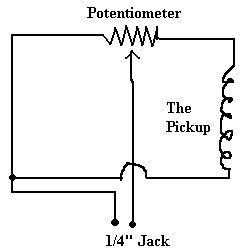The circuitry for the guitar is relatively simple. Here's the circuit diagram:

Guitar circuit diagram.
The leftmost connection in the ¼ jack is a ground connection; the rightmost one connects with an amplification circuit and the speaker in the amplifier. There is always a constant resistance across the full length of the potentiometer, so there is a constant resistance between the potentiometer side of the pickup and ground, ignoring the amplifier. The amplifier has a constant resistance, and it can be treated as a single resistor for the purposes of analyzing this circuit. The potentiometer adjusts the ratio between the resistance in the amplifier circuit path and the path straight to ground. Given Ohm's law, V = IR, and some time to derive the summation of ohmages for serial and parallel circuits (RT = R1 + R2 + ... for series circuits, and 1/RT = 1/R1 + 1/R2 + ... for parallel circuits), the function for the total resistance of the circuit is RT = (1/(100,000 - R1) + 1/(amp resistance constant))-1 + R1, where R1 is the resistance between the wire on the potentiometer that connects directly and only to the pickup, and the wire that runs directly and only to the ¼ jack, the value that is adjusted by turning the volume knob. Although the total resistance of the circuit won't vary greatly, the resistance of the two paths, represented in the formula by (100,000 - R1) and (amp resistance constant) will vary significantly. The greater amount of current will flow down the path with the least resistance, so the amount of power being sent to the amplifier is adjusted by changing the position of the potentiometer. Power corresponds directly (well, logarithmically) with volume, so the potentiometer also adjusts volume.
